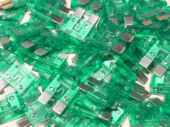
Purpose
To make a model of a fuse. After this experiment, you will realize the importance of the fuse and be able to answer the question, “How can a fuse help prevent fire caused by faulty electrical wiring?”
Additional information
Many devastating fires have been caused by faulty electrical wiring. An overloaded circuit or short circuit can cause fire. Sometimes, there are many devices connected to the outlet. The current drawn by the outlet increases and produces heat that causes the wire to become hot. The hot wiring may ignite the materials surrounding it and start a fire. To prevent fires caused by faulty electrical wiring or devices, fuses are installed in homes, offices, and other infrastructures. A fuse is found in a fuse box. The electric current from the power line fuses to the electric meter and then to the fuse box and so to the establishment wires. A fuse contains a thin piece of metal. When the circuit becomes overloaded, the metal strip melts and destroys the fuse. The current will no longer flow through the circuit unless the burnt fuse is replaced. A short circuit may occur when bare wires come into contact and more current moves in the circuit. It can be caused by damaged or worn out electrical wiring. Sometimes, small animals like rats and rodents chew off parts of the insulation.
Sponsored Links
Required materials
- two dry cells
- flashlight bulb with socket
- two thumbtacks
- two metal paper clips
- 13 x 18 cm wooden block
- 3cm aluminum foil
- half a meter copper wire cut into four
- screw driver
- electrical tape
- scissors
Estimated Experiment Time
Around 30 minutes
Step-By-Step Procedure
- 1. Get two paper clips and tack them on one side of the wooden block.
- 2. Insert the strip of aluminum foil between the paper clips (this acts as the fuse).
- 3. Connect the dry cells by taping one wire to the positive side of the first cell and the other end attached to the negative side of the second cell.
- 4. Get another wire, remove a part of the insulation in the middle, and tape the end on the positive side of the second cell.
- 5. Then attach the other end to the left thumbtack on the wooden block.
- 6. Attach another wire to the negative side of the first dry cell and connect it to the left side of the light bulb.
- 7. Remove a part of the insulation in the middle wire and attach the end to the right side of the light bulb.
- 8. Then wound the other end to the right thumbtack on the wooden block.
Note
Remove the insulation slowly to avoid damaging the wires. Do not play with the thumbtacks to avoid being pricked.
Observation
Did the bulb light up? What happens when you place a screw driver across the bare wires? What happens to the aluminum foil?
Result
Placing a screw driver across the bare wires caused a short circuit because the aluminum which serves as the fuse heats up and breaks the circuit. Safety devices like the fuse can help prevent uncontrolled fires caused by faulty electrical wiring.
Sponsored Links
Take a moment to visit our table of Periodic Elements page where you can get an in-depth view of all the elements,
complete with the industry first side-by-side element comparisons!